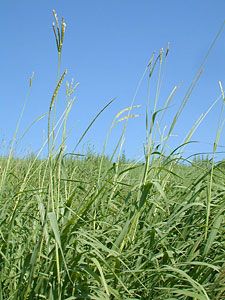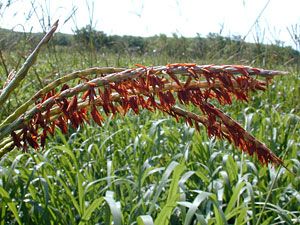Eastern Gamagrass
Tripsacum dactyloides
Family: (Poaceae) Grasses
Habitat: Low-lying prairies
Height: Usually 2-3 ft. Can grow up to 10 ft.
Bloom Period: April - June
Description: Eastern gamagrass is found in the low-lying areas of the coastal prairie in association with Switchgrass (Panicum virgatum). Both are native grasses that are exceptionally large, beautiful components of our prairies. Eastern gamagrass is an ancestor to maize. When it flowers (late March to early October) it has interesting red spikes consisting of separate male and female spikelets. Grass spikelets hold the fruit or grain of grasses for reproduction. When the female spikelets are mature, they break apart like pop-beads that resemble small kernels of corn.
Eastern gamagrass can tolerate both long periods of flooding and drought. This tough, hardy grass has thick, rhizomatous roots that make it an excellent bank stabilizer in erosion control projects. The City of Austin uses it extensively to stabilize creek banks. It is an elegant and dynamic plant found in both partial shade and full sun.
The Wildlife Connection: Eastern gamagrass provides excellent wildlife habitat; the spreading clumps are often hollow in the middle, forming a tented canopy of leaves growing from the ring of rhizomes and falling into the center. This hollow center is extremely large and makes excellent nesting sites for ground-dwelling birds such as quail and prairie-chickens and excellent over-wintering cover for grassland sparrows.

Mike Haddock, Kansas State University

Mike Haddock, Kansas State University


